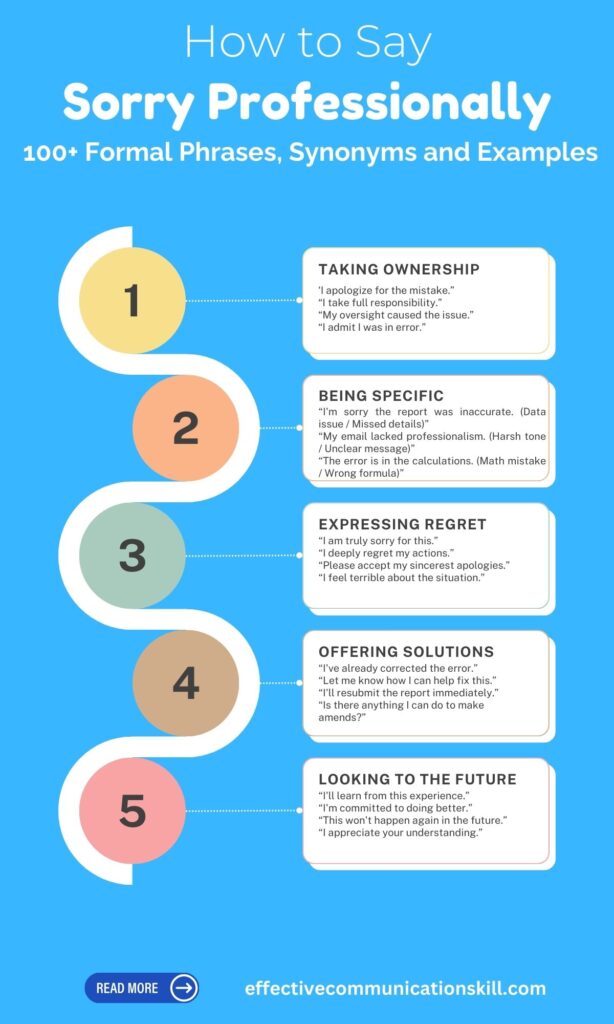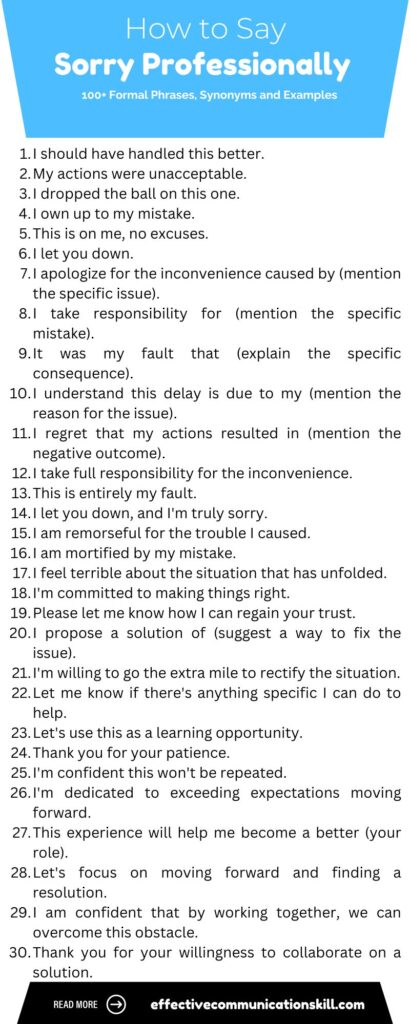How to Say Sorry Professionally
Mistakes happen in every workplace, and sometimes those mistakes necessitate an apology. A well-delivered apology can be the difference between a minor blip and a fractured working relationship.
Studies from the University of California, Berkeley show that effective apologies can actually strengthen relationships by demonstrating empathy and a willingness to take responsibility. However, simply uttering “I’m sorry” may not always be sufficient, particularly in a professional setting.
How to Say Sorry for Your Loss Professionally – Being able to navigate an apology in a professional setting requires knowing “how to say sorry professionally.” This is more than just admitting that you made a mistake; it calls for accepting responsibility, speaking clearly, and pledging to make things right or stop it from happening again.

How to Say Sorry Professionally
Saying sorry effectively involves more than just uttering the words. Here are five key steps to say sorry politely:
1. Be Prompt and Direct
Don’t let the situation fester. The sooner you apologize, the sooner you can begin to move forward. Be clear and concise about why you’re apologizing.
- Example: “I apologize for missing yesterday’s deadline on the Smith project report. I understand this caused an inconvenience, and I’ll have the completed report to you by the end of the day.”
2. Take Ownership
Avoid phrases that deflect blame or minimize the impact of your mistake. Acknowledge your error and express sincere regret.
- Example: “I made a mistake in the data analysis for the Jones campaign. I should have double-checked my calculations before submitting the report. I take full responsibility for this error.”
3. Explain, Don’t Excuse
While a brief explanation can be helpful, focus on taking responsibility rather than making excuses.
- Example: “I understand my late arrival to the meeting this morning disrupted the flow of discussion. There was unexpected traffic on the highway, but I should have allowed extra travel time to ensure I was on time.”
4. Offer Solutions (When Applicable)
If possible, propose a way to rectify the situation. This demonstrates your commitment to learning from the mistake and preventing future occurrences.
- Example: “In addition to completing the Smith report today, I’m happy to stay late to help update the presentation slides to reflect the revised data.”
5. Express Gratitude
Even if the situation isn’t completely resolved, express your appreciation for the recipient’s understanding.
- Example: “Thank you for your patience and flexibility in this situation. I value your collaboration and look forward to working with you to move forward.”
100+ Formal Phrases, Synonyms, and Examples for How to say sorry professionally
Here are some Professional ways to say sorry by utilizing phrases, synonyms and helpful examples for your ease.
Taking Ownership
- I apologize for the mistake.
- I take full responsibility.
- My oversight caused the issue.
- I admit I was in error.
- I should have handled this better.
- My actions were unacceptable.
- I dropped the ball on this one.
- I own up to my mistake.
- This is on me, no excuses.
- I let you down.
Being Specific
- I’m sorry the report was inaccurate. (Data issue / Missed details)
- My email lacked professionalism. (Harsh tone / Unclear message)
- The error is in the calculations. (Math mistake / Wrong formula)
- I missed the deadline for the project. (Delivery delay / Missed target)
- I regret the misunderstanding. (Miscommunication / Wrong assumption)
- I apologize for the inconvenience caused by (mention the specific issue).
- I take responsibility for (mention the specific mistake).
- It was my fault that (explain the specific consequence).
- I understand this delay is due to my (mention the reason for the issue).
- I regret that my actions resulted in (mention the negative outcome).
Expressing Regret
- I am truly sorry for this.
- I deeply regret my actions.
- Please accept my sincerest apologies.
- I feel terrible about the situation.
- There are no excuses for my mistake.
- I wish I had handled this differently.
- My behavior was unprofessional.
- I take full responsibility for the inconvenience.
- This is entirely my fault.
- I let you down, and I’m truly sorry.
- I am remorseful for the trouble I caused.
- I am mortified by my mistake.
- I feel terrible about the situation that has unfolded.
Offering Solutions
- I’ve already corrected the error.
- Let me know how I can help fix this.
- I’ll resubmit the report immediately.
- Is there anything I can do to make amends?
- I’ll be more realistic about deadlines.
- I’m happy to fix the issue myself.
- Let’s discuss a solution together.
- I’ll take steps to prevent this from happening again.
- I’m committed to making things right.
- Please let me know how I can regain your trust.
- I propose a solution of (suggest a way to fix the issue).
- I’m willing to go the extra mile to rectify the situation.
- Let me know if there’s anything specific I can do to help.
Looking to the Future
- I’ll learn from this experience.
- I’m committed to doing better.
- This won’t happen again in the future.
- I appreciate your understanding.
- Let’s move forward constructively.
- I value your trust and will work to regain it.
- I’m committed to improvement.
- I’ll be more mindful in the future.
- Let’s use this as a learning opportunity.
- Thank you for your patience.
- I’m confident this won’t be repeated.
- I’m dedicated to exceeding expectations moving forward.
- This experience will help me become a better (your role).
Minimizing Blame (Use with Caution)
- There seems to have been a misunderstanding.
- Unfortunately, unforeseen circumstances resulted in this issue.
- It is important to consider all contributing factors to this situation.
- While I acknowledge my role, there may have been external influences at play.
- I would be happy to discuss the situation further to ensure clarity.
- Perhaps a different approach could have yielded a better outcome.
- Let’s focus on moving forward and finding a resolution.
- I am confident that by working together, we can overcome this obstacle.
- Thank you for your willingness to collaborate on a solution.
- I am committed to learning from this experience and improving future outcomes.
Formal Phrases for Acknowledging Shortcomings
- There is room for improvement in how I handled this situation.
- I recognize that my actions fell short of expectations.
- It’s evident that I could have been more (mention specific quality, e.g., thorough, efficient) in this process.
- I am open to feedback on how I can better serve you/the team in the future.
- I appreciate your patience as I work to refine my skills in this area.
Formal Phrases for Highlighting Lessons Learned
- This experience has provided valuable insights that I will apply moving forward.
- I am committed to using this situation as a learning opportunity to grow professionally.
- I am confident that the lessons learned here will lead to improved performance in the future.
- I am eager to put these learnings into practice to better serve you/the team.
- Thank you for your understanding as I strive for continuous improvement.
Formal Phrases for Emphasizing Collaboration
- I believe a collaborative approach can help us overcome this challenge.
- I am open to working together to find a solution that benefits everyone.
- Let’s leverage our combined expertise to find the best path forward.
- I am confident that through open communication and collaboration, we can achieve a positive outcome.
- Thank you for your willingness to partner with me in resolving this issue.
Formal Phrases for Regaining Trust
- I understand that rebuilding trust takes time, and I am committed to the process.
- I am confident that through my actions, I can regain your trust.
- I am open to any suggestions you may have on how I can demonstrate my trustworthiness.
- I value your trust immensely, and I will work diligently to earn it back.
- Thank you for your patience as I strive to regain your confidence.
Helpful Examples for Deep Understanding
Here are other ways to say sorry politely and more efficiently with the help of examples.
- How to Apologize Without Saying Sorry Professionally
- Take Full Responsibility: “I dropped the ball on this one. Let me know how I can help fix it.”
- Acknowledge the Impact: “I understand this delay may have caused a setback. I’m working diligently to get back on track.”
- Offer a Solution: “I’ve already corrected the error in the report. I’ll be resubmitting it immediately.”
- Focus on Moving Forward: “Thank you for your patience. Let’s discuss a solution to ensure this doesn’t happen again.”
- Express Appreciation for Understanding: “I appreciate your understanding in this matter. I’m committed to doing better in the future.”
- How to Say Sorry I Missed Your Call Professionally
- Acknowledge the Missed Call and Express Regret: “I apologize for missing your call earlier today. I regret any inconvenience this may have caused.”
- Offer to Reconnect: “Would it be convenient to reschedule our call? I’m available at your earliest convenience.”
- Provide Context (Optional): “If it’s urgent, please don’t hesitate to reply to this email with the details.”
- Express Appreciation for Their Time: “Thank you for your understanding. I look forward to connecting soon.”
- Set Up Auto-Responder (For Frequent Call Misses): Consider setting an auto-responder during busy periods that informs callers you’ll return their call by a specific time.
- How to Say Sorry in Email Professionally
- Start with a Clear Subject Line: “Missed Deadline: [Project Name]” or “Apology for Error: [Report Title]” clearly states the issue.
- Acknowledge the Mistake or Delay: “I am writing to apologize for the delay in submitting the [project name].”
- Explain the Reason (Optional): Briefly explain the reason for the delay/mistake, but avoid making excuses.
- Offer a Solution or Reassurance: “I’ve already completed the task and attached the updated report.”
- Express Gratitude and Move Forward: “Thank you for your understanding. Please let me know if you have any questions.”
- How to Professionally Say Sorry for the Delay
- Acknowledge the Delay and Impact: “I apologize for the delay in [project/delivery/response]. I understand this may have caused inconvenience and appreciate your patience.”
- Explain the Reason (Optional): Briefly explain the reason for the delay, but avoid making excuses. Focus on solutions.
- Provide a Revised Timeline: “I anticipate having this completed by [new deadline].”
- Offer Updates: “I’ll keep you updated on my progress in the meantime.”
- Express Gratitude for Understanding: “Thank you for your understanding. Please don’t hesitate to reach out if you have any questions.”

- How to Professionally Say Sorry for a Mistake
- Acknowledge the Mistake and Take Ownership: “I apologize for the mistake in [report/presentation/task]. I take full responsibility for the error.”
- Explain the Impact (Optional): Briefly explain the impact of the mistake, but focus on how you’ll fix it.
- Offer a Solution: “I’ve already corrected the error and [explain what you did to fix it].”
- Preventative Measures (Optional): “I’m implementing new procedures to ensure this doesn’t happen again.”
- Reiterate Your Commitment: “I’m committed to delivering high-quality work and appreciate your understanding.”
- How to Say Sorry for Being Annoying Professionally
- Acknowledge Your Actions: “I apologize if my [actions/questions/requests] have been any inconvenience or annoyance.”
- Explain Your Intent (Optional): Briefly explain your intentions if relevant, but avoid dwelling on it.
- Offer to Adjust Your Approach: “I’m happy to adjust my approach moving forward. Please let me know how I can best support you.”
- Express Appreciation: “Thank you for your patience and understanding.”
- Move Forward: “I look forward to collaborating productively with you.”
- How to Say Sorry for Bothering You Professionally
- Acknowledge the Interruption: “I apologize for bothering you, but…”
- State Your Reason Concisely: Briefly explain why you’re reaching out and keep your message to the point.
- Offer Alternatives (Optional): “Would it be better if I followed up later?”
- Express Appreciation for Their Time: “Thank you for your time and consideration.”
- Close with a Clear Call to Action (Optional): “Please let me know if you have any questions or require further information.”
- How to Say I’m Sorry to Hear That Professionally
- Acknowledge Their Situation: “I’m sorry to hear about [mention the situation briefly].”
- Offer Support (Optional): “Is there anything I can do to help?”
- Express Empathy: “That sounds like a difficult situation.”
- Offer Words of Encouragement (Optional): “I know you’re capable of handling this.”
- Move Forward: “Please keep me updated if there’s anything I can do.”
- How to Say Sorry for Being Late Professionally
- Acknowledge You’re Running Late: “I apologize for running late to our meeting today.”
- Explain the Reason (Optional): Briefly explain the reason for being late, but avoid going into excessive detail.
- Express Regret and Appreciation: “I regret any inconvenience this may cause. Thank you for your understanding.”
- Suggest Solutions (Optional): “Would you like to reschedule, or should we proceed remotely?”
- Be Prepared: If possible, arrive prepared to jump into the meeting quickly and efficiently.
- How to Professionally Say I’m Sorry You Feel That Way
- Acknowledge Their Feelings: “I’m sorry you feel that way.”
- Seek Clarification (Optional): “Can you tell me more about why you feel that way?”
- Validate Their Perspective: “I understand why you might feel frustrated/disappointed/upset (depending on the situation).”
- Offer Solutions or Next Steps: “Let’s discuss how we can move forward and address your concerns.”
- Express a Desire to Improve: “I value your feedback and am committed to finding a solution that works for everyone.”
- How to Professionally Say Sorry for Wasting Your Time
- Acknowledge the Time Spent: “I apologize for taking up your time today.”
- Explain the Situation (Optional): Briefly explain the reason for the meeting/call if it didn’t go as planned.
- Express Appreciation: “Thank you for your time and consideration.”
- Offer Follow-Up (Optional): “Perhaps we can revisit this at a later time when [explain the condition for revisiting].”
- Move Forward: “Thank you again. I wish you all the best.”
- How to Say Sorry I’m Sorry I Can’t Make It Professionally
- Acknowledge the Invitation and Regret: “Thank you for the invitation, but I apologize that I won’t be able to make it to [event name].”
- Explain Your Reason (Optional): Briefly explain why you can’t attend, but avoid going into unnecessary detail.
- Offer Alternatives (Optional): “Would it be possible to reschedule, or can I participate remotely?”
- Express Gratitude and Well Wishes: “Thank you for your understanding. I wish you a successful event.”
- Offer Follow-Up (Optional): “I’d be happy to hear a summary of the key takeaways afterwards.”
- How to Professionally Say Sorry for the Late Reply
- Acknowledge the Delayed Response: “I apologize for the late reply to your email.”
- Explain the Reason (Optional): Briefly explain the reason for the delay, but avoid making excuses.
- Address Their Inquiry: Respond directly to the questions or requests in their original email.
- Express Appreciation: “Thank you for your patience and understanding.”
- Move Forward: “Please let me know if you have any further questions.”
- How to Professionally Say Sorry for the Inconvenience
- Acknowledge the Inconvenience: “I apologize for any inconvenience this may cause.”
- Explain the Situation (Optional): Briefly explain the reason for the inconvenience, but focus on solutions.
- Offer Solutions or Alternatives: “We are working to resolve the issue as quickly as possible. In the meantime, [explain alternative options].”
- Express Appreciation for Patience: “Thank you for your patience and understanding.”
- Provide Updates (Optional): “We will keep you updated on the progress of the resolution.”
- How to Professionally Say Sorry for All the Questions
- Acknowledge the Number of Questions: “I apologize for the number of questions I have.”
- Explain Your Desire to Understand: “I’m eager to learn more about [topic] and ensure I fully grasp the situation.”
- Express Appreciation for Their Time: “Thank you for your patience and willingness to answer my questions.”
- Offer to Summarize (Optional): “Can I summarize what I’ve learned so far to ensure I’m on the right track?”
- Move Forward: “Please let me know if there’s anything else I need to clarify.”
How to Say Sorry Professionally: Examples in Action
Let’s see these phrases and synonyms used in real-world scenarios to say sorry formally:
Scenario 1: A colleague approaches you overwhelmed because they can’t access an important file.
- You (using phrases from Minimizing Blame): “There seems to have been a misunderstanding regarding file access. Perhaps a different permission setting could resolve this.”
- You (using phrases from Taking Ownership): “I apologize for the inconvenience this is causing. Let’s troubleshoot this together and see if we can get you access to the file.”
- You (using phrases from Offering Solutions): “I’m happy to check the file permissions or reach out to IT for further assistance. In the meantime, is there another version of the file you can access?”
Scenario 2: You accidentally deliver a presentation with outdated information.
- You (using phrases from Acknowledging Shortcomings): “I recognize that the information presented may not be entirely accurate. There have been some recent updates I should have incorporated.”
- You (using phrases from Highlighting Lessons Learned): “This experience highlights the importance of staying up-to-date on project developments. I’ll be sure to double-check information before future presentations.”
- You (using phrases from Taking Ownership): “I take full responsibility for this oversight. I’m re-working the presentation with the latest information and will resend it immediately.”
Scenario 3: You miss an important client call due to unforeseen circumstances.
- You (using phrases from Saying Sorry I Missed Your Call Professionally): “I apologize for missing your call earlier today. It appears my phone malfunctioned during that time. I regret any inconvenience this may have caused.”
- You (using phrases from Offering to Reconnect): “Would it be convenient to reschedule our call? I’m available at your earliest convenience.”
- You (using phrases from Expressing Appreciation for Their Time): “Thank you for your understanding. I look forward to connecting soon and apologize again for the missed call.”
Scenario 4: You need to ask your manager for an extension on a project deadline.
- You (using phrases from Professionally Saying Sorry for the Delay): “I apologize for the potential delay in completing the [project name] project. I understand this may impact the timeline, and I appreciate your patience.”
- You (using phrases from Explaining the Reason (Optional)): “I encountered some unforeseen challenges with [mention the reason for the delay] that require additional time to ensure high-quality work.”
- You (using phrases from Providing a Revised Timeline): “I anticipate having this completed by [new deadline] and will keep you updated on my progress.”
Scenario 5: You accidentally send an email containing a typo-ridden draft to a client.
- You (using phrases from Saying Sorry in Email Professionally): “I am writing to apologize for the unprofessional draft you may have received earlier. Due to a system glitch, an incomplete version of the email was sent.”
- You (using phrases from Offering a Solution or Reassurance): “I’ve attached the final, corrected version of the email for your reference. Please disregard the previous draft.”
- You (using phrases from Expressing Gratitude and Moving Forward): “Thank you for your understanding. Please let me know if you have any questions about the revised document.”
Scenario 6: A colleague feels you haven’t been acknowledging their contributions to a project.
- You (using phrases from Saying Sorry You Feel That Way): “I’m sorry you feel that your contributions haven’t been recognized. I value your hard work on this project.”
- You (using phrases from Seeking Clarification (Optional)): “Can you tell me more about specific instances where you felt your input wasn’t acknowledged?”
- You (using phrases from Expressing a Desire to Improve): “I’m committed to creating a more collaborative work environment. How can I better acknowledge everyone’s efforts in the future?”
Scenario 7: You realize you’ve been asking a lot of questions from a busy colleague and may be hindering their workflow.
- You (using phrases from How to Say Sorry for Being Annoying Professionally): “I apologize if my numerous questions have been any inconvenience. I’m eager to learn the ropes, but I understand this might be a busy time for you.”
- You (using phrases from Offering to Adjust Your Approach): “I’m happy to prioritize my questions and perhaps schedule a dedicated time to go through them with you. Please let me know what works best for you.”
- You (using phrases from Expressing Appreciation): “Thank you for your patience and understanding as I get acclimated to my new role.”
Scenario 8: You accidentally deliver an incorrect report to a team member.
- You (using phrases from Professionally Saying Sorry for a Mistake): “I apologize for the mistake in the report I sent you earlier. I take full responsibility for the error.”
- You (using phrases from Explaining the Impact (Optional)): “The data on page [X] is inaccurate. This may impact your analysis, and I sincerely regret any confusion this may cause.”
- You (using phrases from Offering a Solution): “I’ve already corrected the error and sent you the updated version. Please let me know if you have any questions.”
Scenario 9: You need to inform a client about a price increase for their project.
- You (using phrases from Professionally Saying Sorry for the Inconvenience): “We apologize for any inconvenience this may cause, but due to unforeseen cost increases with [explain the reason], we need to adjust the project pricing.”
- You (using phrases from Explaining the Situation (Optional)): “We’ve explored all possible cost-saving measures, but unfortunately, this price increase is necessary to maintain the project’s quality.”
- You (using phrases from Offering Solutions or Alternatives): “We’re happy to discuss alternative options or scope adjustments to fit your budget. We’re committed to finding a solution that works for everyone.”
Scenario 10: You accidentally interrupt a colleague during an important meeting.
- You (using phrases from How to Say Sorry for Bothering You Professionally): “I apologize for interrupting you during your presentation. I didn’t mean to disrupt the flow.”
- You (using phrases from Stating Your Reason Concisely): “I just wanted to clarify a point regarding [mention the specific point] if that’s alright.”
- You (using phrases from Offering Alternatives (Optional)): “Perhaps I can wait until after the presentation to discuss this further, or would you prefer to address it now?”

Conclusion
Delivering a sincere apology is crucial in any professional setting. Knowing how to say sorry professionally demonstrates accountability, maintains positive relationships, and fosters trust.
This guide offered various scenarios and phrased alternatives to express regret, take ownership, and move forward constructively. By mastering these skills, you can effectively navigate challenging situations and build a strong reputation in the workplace.
